Session 1.3. Epidemics: introduction and definitions
By the end of this session, you will be able to:
- Explain what an epidemic is.
- Describe how epidemics spread and their cycle.
- Explain vulnerability to epidemics.
- List the conditions that help to spread epidemics.
Part 1.3.1. What is an epidemic?
To understand what an epidemic is, we need to understand what an infection is and what causes infections. An epidemic occurs when an infection causes an unusually high number of people to fall ill at the same time.
First, let us define an infection.
| An infection |
|---|
| is caused by a germ. An infection may lead to a disease. Different kinds of germ cause different kinds of disease. A germ can be transmitted in several different ways, both between people and between animals and people. |
There are many kinds of infections, which can cause a variety of diseases, including diarrhoea, respiratory infections, poliomyelitis and measles. The diseases that are due to infections can result in epidemics. We will talk about each of the diseases later in the manual.
In the next part of the session, we will also learn more about germs, how they cause infections and how they travel from a person or animal to another person.
Participate
Choose a word that describes what you think when you hear the word “epidemic”.
What is it? How does it happen? What causes it?
Give your word to the facilitator, who will write it on the flip chart. Write the word down in this box or on a piece of paper. Then copy all the words your colleagues suggest into the box as well.
All the words you see in the box above give you a better idea of what an epidemic is, how it happens, why it happens, and how it affects people and communities. Here is the definition of an epidemic:
| An epidemic |
|---|
| occurs in a community when more people than usual have the same infection at the same time. |
Please see 4.6.1 for a list of diseases that are prone to become epidemic. Several things together therefore make an epidemic:
- There is an infection.
- It affects the community.
- More people than usual fall sick.
- They fall sick at the same time.
Part 1.3.2. Infection and epidemic cycles
Now we know the definitions of an infection and an epidemic, we can talk more about how they happen and how they affect people and communities.
Infection cycle
As we noted earlier, infections lead to diseases that affect people and make them sick. People fall sick with a disease when germs that cause an infection enter their bodies and their bodies are unable to fight the disease or overcome the disease at once.
We have mentioned germs several times. What are they?
| A germ |
|---|
|
is a very small organism that we cannot see with our eyes. There are different kind of germ: viruses, bacteria, fungi and parasites. Germs affect people and animals and can make them sick. They travel from one person or animal to another person, causing a disease to spread (which may result in an epidemic). |
Here are a few things to remember about germs:
- They are living creatures.
- They are so small that we cannot see them with our eyes.
- They can enter our bodies in different ways (as we breathe, via the mouth, insect bites, sexual contact, through broken skin and wounds, during breastfeeding, from mother to child during pregnancy).
- Some germs can make us sick when they enter our bodies.
- They can travel from a person or an animal to another person in different ways.
Germs are everywhere around us. They can be found in the ground, in water and food, on our hands, on other objects we touch. But how do those germs get into our bodies and cause diseases? And how do they travel from one person to another?
To understand how germs spread, we need to look at the infection cycle. Take a good look at Figure 4 (Session 1.3), which shows how germs can infect a person and make them sick.
The diagram reveals several important things:
- Infections are caused by germs.
- Germs spread from a person or from an animal to other person or animal.
- Different kinds of germ cause different kinds of infection.
- Germs spread and infect new people in different ways:
- Directly, for example through touching, coughing, sneezing or having sex.
- Indirectly, via a vector, or via water, food, air, soil or objects.
- When a germ enters a healthy person, he or she can fall sick. A sick person sometimes recovers, sometimes acquires immunity (is protected) from the disease, sometimes remains infected, or may die as a result of the infection.
- Some people are infected by a germ but do not get sick. We will discuss why this happens later in the session. For now it is important to remember that, even if such people do not fall sick, even if they look healthy, they can spread the germs they have to other people. They are called carriers.
- Infectious diseases occur to some extent all the time in every community. However, sometimes a disease affects many more people than usual at the same time and the community is unable to cope. This is then an epidemic.
Discuss the above points with your facilitator and your colleagues. Make sure each point is clear to you.
Give examples of the different routes of transmission.
Direct transmission
We have mentioned direct transmission through coughing or sneezing. This is known as droplet transmission.
| Droplet transmission |
|---|
| occurs when oral or nasal secretions containing germs that cause an illness enter the eyes, nose or mouth of another person. |
A germ can also be transmitted directly from person to person.
| Person to person transmission |
|---|
| occurs when an infected person touches or exchanges body fluids with someone else. Direct contact occurs when we touch, kiss or have sex. |
Indirect transmission
Indirect transmission occurs when diseases spread to people who have no direct contact with or are not close to an infected person.
Air-borne transmission is a form of indirect transmission. How is air-borne transmission different from droplet transmission?
| Air-borne transmission |
|---|
| occurs when germs from a sick person remain in the air for a period of time, and then enter the nose or mouth of another person. |
Transmission can also take place when we touch objects that a sick person has touched or infected. Think of the different actions you could take to prevent this type of transmission.
| Contaminated objects |
|---|
| Germs from coughs, sneezes or other body fluids, such as blood, can live for some time on toys, household utensils, door handles, medical equipment and other objects. Transmission occurs when a person who is not infected touches a contaminated object and germs on that object enter his or her body through the skin, eyes, nose or mouth. |
This is a transmission route that is easily prevented by following recommended hygiene practices. (See action tool 29: Hygiene promotion.)
| Food and drinking water |
|---|
| Germs can be transmitted via food and water that have been contaminated by faecal matter (stools/poop), other body fluids or unsafe hygiene practices. |
Germs can also be spread by vectors. What are vectors?
| A vector |
|---|
| is an insect or an animal that can carry germs and transmit them to people. Vectors include mosquitoes, flies, rats, fleas, bats, chickens and monkeys. |
Illustration 1. Vectors: mosquito, flea, fly and rat
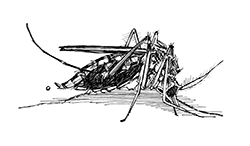
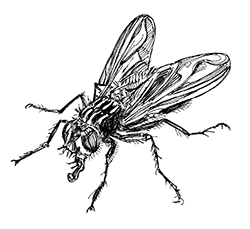
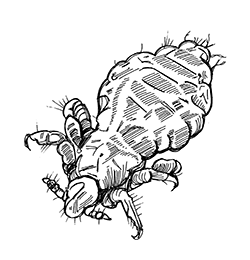

The spread of an epidemic
Infectious diseases are present to some extent all the time in any community. But sometimes a disease spreads more actively, affecting many more people than usual at the same time and causing more sickness and sometimes more deaths than the community is able to cope with. This is an epidemic.
Many different diseases can cause epidemics. We will talk about these in the next session. For now, we will try to understand how germs that are transmitted from one person to another or from animals to humans spread and can become an epidemic.
Look closely at the following drawing and try to understand how a single person can pass on an infection to several other people, causing it to spread.
Figure 3. The spread of infection
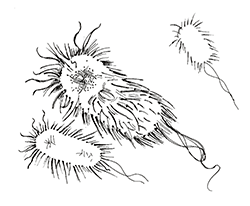
Because one ill person or a vector can infect many people, an epidemic can start when one or a few people fall sick. Those who are infected then spread the infection even more widely to more people.
It is important to remember that not everyone who is infected by a germ falls sick. Some people can resist an infection. These people have immunity or have a very mild infection that goes unnoticed. If they are carriers, however, they can still pass the germs to other people. In addition, some individuals are more vulnerable to disease because they are not well nourished or have other diseases that reduce their resistance or immunity to disease. (This means that their bodies are unable to produce enough antibodies to fight bacteria and viruses, and as a result they fall ill more frequently.)
| Immunity |
|---|
| is the ability to fight off an infection. A person who is immune to an infection may have had that infection before and developed a resistance to it; or may have been vaccinated against that infection. |
An epidemic occurs when the number of sick people in a community increases. More people become infected than in normal situations, exceeding the community’s ability to cope.
An epidemic occurs for one of several reasons:
- The germs are more active than usual (for instance, they are a new kind of germ).
- The germs have been introduced into a community for the first time, so the population has no immunity to them.
- A vector that carries the germs has arrived in a community for the first time.
- The number of vectors has increased (for example, mosquitoes have multiplied during the rainy season).
- People are less able to resist the germs, because they suffer from malnutrition and because few people have immunity.
- Germs have multiplied because the surrounding environment has deteriorated or has not been properly maintained (for example, there is insufficient water or water sources have been polluted).
- People have more contact with one another (for example, because they are living in refugee camps) or with animals (for example, following deforestation).
- Few (or fewer) people are vaccinated.
To control epidemics effectively, it is important to think of the factors that cause an epidemic to spread. This can be done by understanding the infection that is causing the epidemic and the environment in which it is spreading.
Role-play
Your facilitator will choose one of you to play the part of the person who first catches an infection. This disease can spread from one person to another by shaking hands.
The “infected person” will go round and shake hands with other people. The people with whom he or she shakes hands also become “sick”.
See how many people get sick in a very short time.
This exercise will help you to “see” how epidemics spread.
Figure 4.The spread of disease
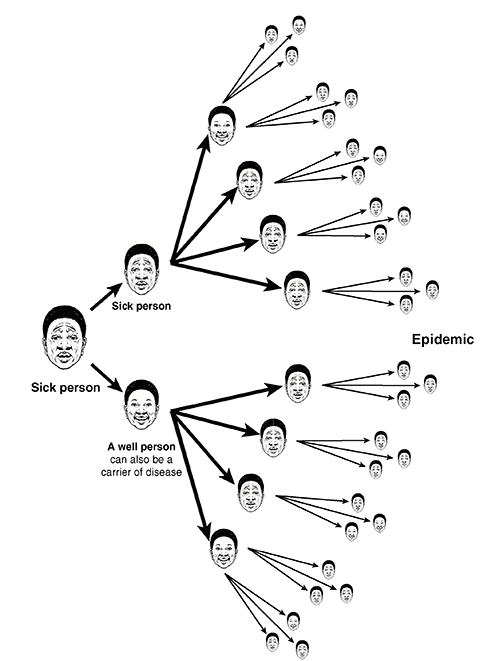
Part 1.3.3. What helps epidemics to spread?
We have noted that the germs that cause epidemics spread directly from person to person or from an animal to a person, or spread indirectly through the surrounding environment or via a vector.
Normally, a balance of factors prevents a disease from spreading and causing an epidemic. These factors include:
- The nature of the disease and its presence and vitality.
- The community in which the disease exists, and the community’s living conditions, habits and practices.
- The environment, including the seasons, water and sanitation conditions, and the presence of vectors.
Look at the diagram below and imagine how a change in one of the three elements listed above (the disease, the environment, the community) can help a disease to spread and cause an epidemic.
Figure 5. Disease, environment and community
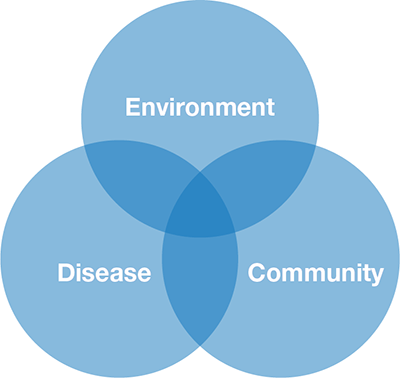
Several things can increase the spread of an epidemic and make people weaker and more likely to become sick.
Remember that epidemics start to spread when, for one or more reasons, the balance between germs, vectors, people and the environment changes.
Participate
Tell your facilitator what things you think help to spread diseases. Think of diseases that spread directly, by coughing or touching, diseases that spread through mosquitoes, and diseases that spread through dirty water or poor sanitation. Write down in this box all the things that cause diseases to spread.
For example: Dirty hands, More mosquitoes near ponds
You can see from your answers that many things help spread diseases and cause epidemics. You have to keep all of them in mind when you work to prevent and control epidemics because doing so will help you to show people in your community how they can protect themselves and stop diseases from spreading.
These things will become much clearer in the next session when we discuss the different kinds of disease that cause epidemics and how each spreads.
Part 1.3.4. Who is vulnerable?
Germs and infectious diseases do not affect everyone in the same way. Some people fall sick easily or develop complications when they come into contact with germs, while others do not. This is what we mean when we talk about vulnerability. The more vulnerable people are, the easier it is for them to become sick.
In general, we know why and how some people in a community are more vulnerable than others. For example, it is often because they are poor, already ill, or disabled. Now, we need to think about what other sorts of people in the community might be vulnerable to infections and why.
Knowing which groups are vulnerable to infections is very important. It will give us an idea of who to protect and how.
Participate
Below is a list of categories of people. In small groups, look at each category and mark whether you think the people in it are vulnerable to infectious diseases or not, and say why.
When deciding whether a particular category is vulnerable or not, keep in mind the things that help spread infections.
| Category | Vulnerability | Why |
|---|---|---|
| Babies | ||
| Children | ||
| Pregnant women | ||
| Healthy working people | ||
| Elderly people | ||
| Soldiers | ||
| Farmers | ||
| Factory workers | ||
| HIV+ people | ||
| Poor | ||
| Single parents and widows | ||
| Healthcare workers | ||
| Others |
Some of the people mentioned above are vulnerable to all kinds of infection, while others are vulnerable only to some, depending on their circumstances, the way in which infections spread, and other factors.
Now think of other sorts of people who might be vulnerable in your community and why.